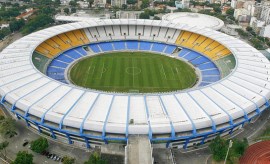
by Shane Henson — June 23, 2014—With all eyes on the 2014 FIFA World Cup in Brazil, the U.S. Green Building Council (USGBC) is proud of the fact that six World Cup stadiums have achieved LEED certification, including South America’s largest stadium, Maracanã, in Rio de Janeiro. LEED, or Leadership in Energy and Environmental Design, is a green building certification program that recognizes best-in-class building strategies and practices.
Originally built and used for the 1950 FIFA World Cup, the LEED silver Maracanã stadium is once again reprising its role by playing host for the final game of the 2014 World Cup. Maracanã will also serve as a major sporting venue for the Rio 2016 Olympic Games, hosting both the opening and closing ceremonies as well as major sporting events.
The other LEED-certified stadiums for the 2014 FIFA World Cup include Castelao Arena in Fortaleza (LEED certified), Arena Fonte Nova in Salvador (LEED silver), Mineirão in Belo Horizonte (LEED silver), Arena da Amaznia in Manaus (LEED silver), and Arena Multiuso in Salvador (LEED silver).
“Even as the world’s top teams take the field, the venues themselves are also in the spotlight, demonstrating not only the worldwide applicability and adaptability of the LEED green building rating system, but also Brazil’s leadership position at the forefront of the movement to high-performing green buildings,” said Rick Fedrizzi, president, CEO and founding chair of USGBC.
Each stadium incorporated multiple sustainable features that contributed to its LEED certification, says the USGBC. For example, Castelao Arena features a 67.6% reduction in drinkable water consumption and a 12.7% reduction in annual energy consumption, while 97% of the project waste was diverted from the landfill. Arena Fonte Nova, meanwhile, used 20% of its building materials made from recycled content, diverted 75% of the project’s construction waste from the landfill, and purchased 35% of its power from renewable sources like solar and wind.
Brazil is among the top five countries worldwide with LEED-certified projects, encompassing nearly 3 million gross square meters of LEED-certified space, says the USGBC.





